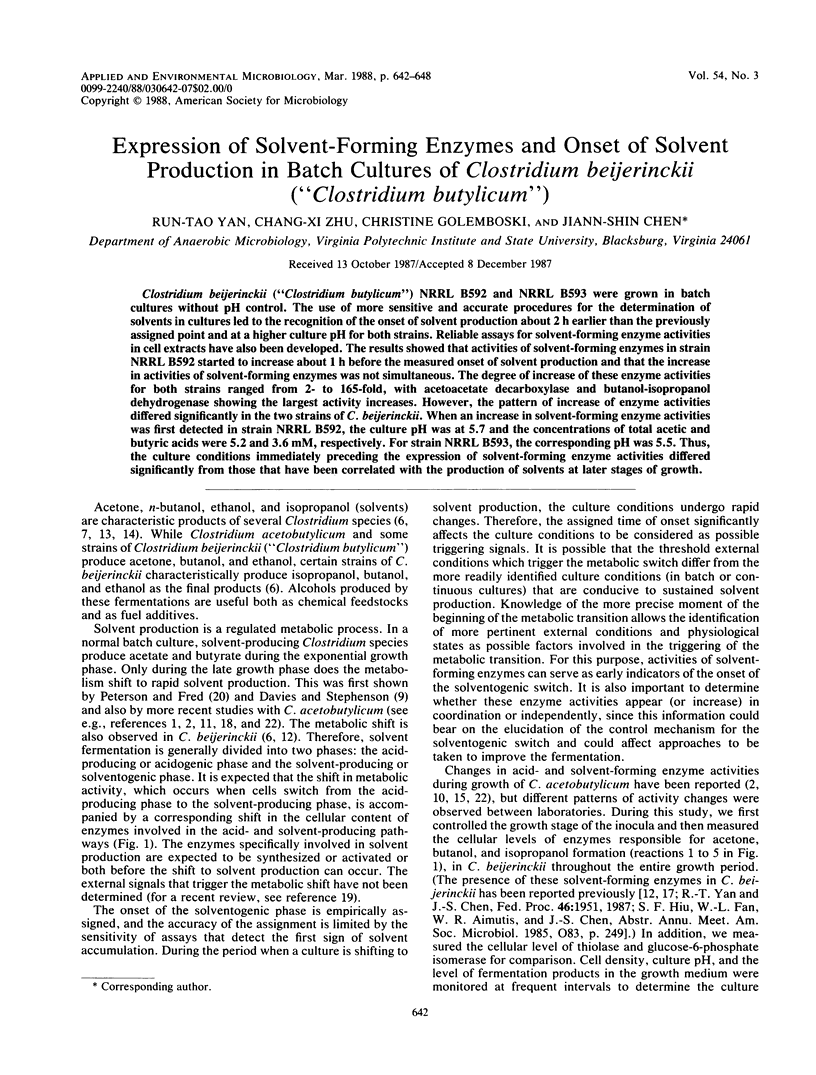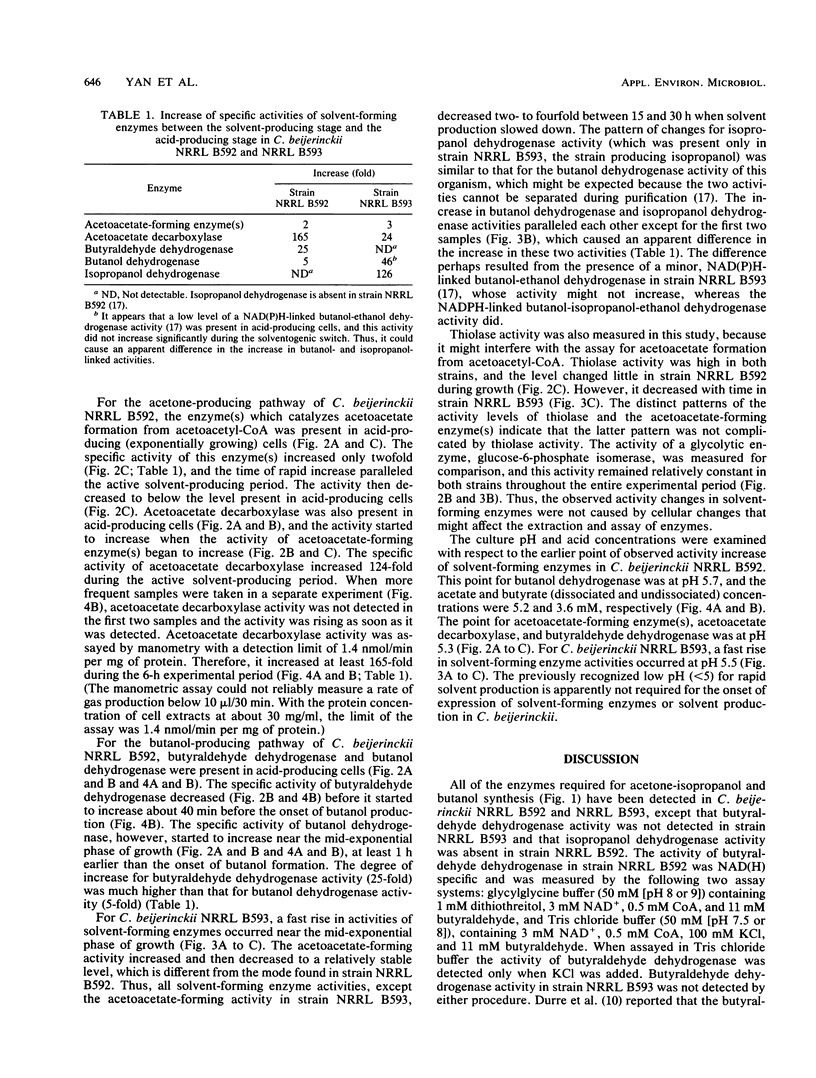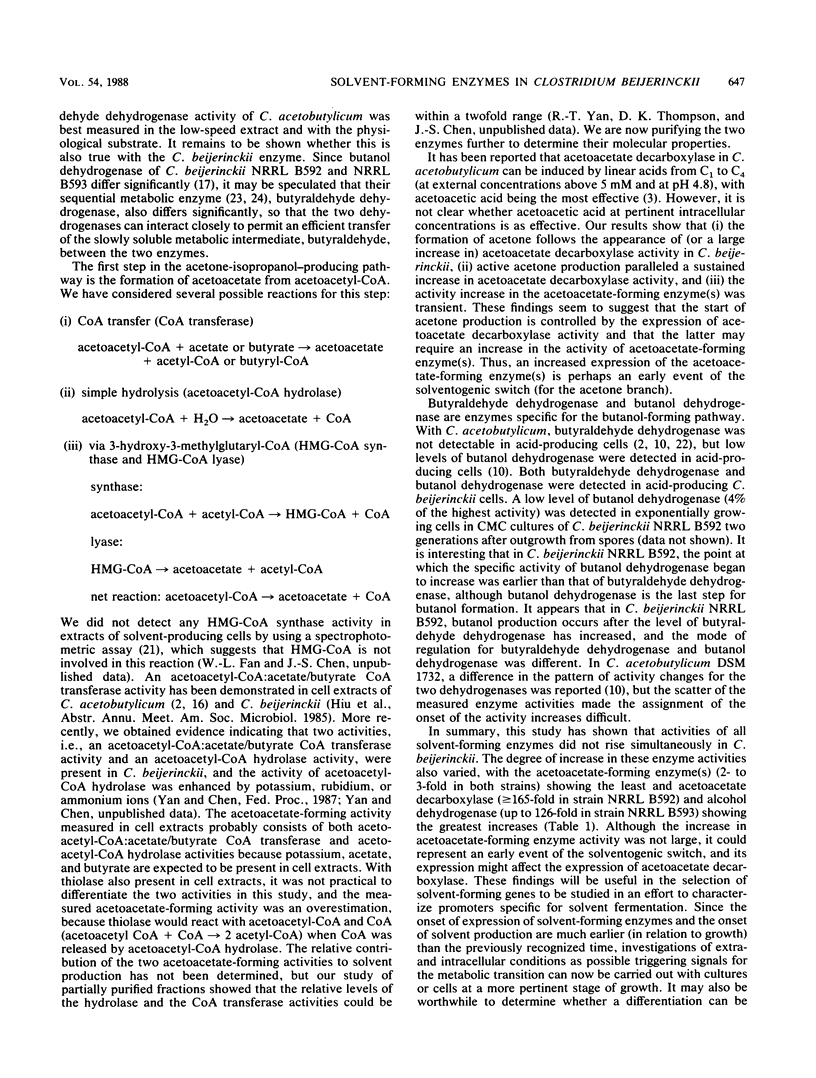Abstract
Clostridium beijerinckii (“Clostridium butylicum”) NRRL B592 and NRRL B593 were grown in batch cultures without pH control. The use of more sensitive and accurate procedures for the determination of solvents in cultures led to the recognition of the onset of solvent production about 2 h earlier than the previously assigned point and at a higher culture pH for both strains. Reliable assays for solvent-forming enzyme activities in cell extracts have also been developed. The results showed that activities of solvent-forming enzymes in strain NRRL B592 started to increase about 1 h before the measured onset of solvent production and that the increase in activities of solvent-forming enzymes was not simultaneous. The degree of increase of these enzyme activities for both strains ranged from 2- to 165-fold, with acetoacetate decarboxylase and butanol-isopropanol dehydrogenase showing the largest activity increases. However, the pattern of increase of enzyme activities differed significantly in the two strains of C. beijerinckii. When an increase in solvent-forming enzyme activities was first detected in strain NRRL B592, the culture pH was at 5.7 and the concentrations of total acetic and butyric acids were 5.2 and 3.6 mM, respectively. For strain NRRL B593, the corresponding pH was 5.5. Thus, the culture conditions immediately preceding the expression of solvent-forming enzyme activities differed significantly from those that have been correlated with the production of solvents at later stages of growth.
Full text
PDF






Selected References
These references are in PubMed. This may not be the complete list of references from this article.
- Bradford M. M. A rapid and sensitive method for the quantitation of microgram quantities of protein utilizing the principle of protein-dye binding. Anal Biochem. 1976 May 7;72:248–254. doi: 10.1016/0003-2697(76)90527-3. [DOI] [PubMed] [Google Scholar]
- Davies R., Stephenson M. Studies on the acetone-butyl alcohol fermentation: Nutritional and other factors involved in the preparation of active suspensions of Cl. acetobutylicum (Weizmann). Biochem J. 1941 Dec;35(12):1320–1331. doi: 10.1042/bj0351320. [DOI] [PMC free article] [PubMed] [Google Scholar]
- Davies R. Studies on the acetone-butanol fermentation: 4. Acetoacetic acid decarboxylase of Cl. acetobutylicum (BY). Biochem J. 1943 Jul;37(2):230–238. doi: 10.1042/bj0370230. [DOI] [PMC free article] [PubMed] [Google Scholar]
- George H. A., Chen J. S. Acidic Conditions Are Not Obligatory for Onset of Butanol Formation by Clostridium beijerinckii (Synonym, C. butylicum). Appl Environ Microbiol. 1983 Aug;46(2):321–327. doi: 10.1128/aem.46.2.321-327.1983. [DOI] [PMC free article] [PubMed] [Google Scholar]
- George H. A., Johnson J. L., Moore W. E., Holdeman L. V., Chen J. S. Acetone, Isopropanol, and Butanol Production by Clostridium beijerinckii (syn. Clostridium butylicum) and Clostridium aurantibutyricum. Appl Environ Microbiol. 1983 Mar;45(3):1160–1163. doi: 10.1128/aem.45.3.1160-1163.1983. [DOI] [PMC free article] [PubMed] [Google Scholar]
- Gottwald M., Hippe H., Gottschalk G. Formation of n-Butanol from d-Glucose by Strains of the "Clostridium tetanomorphum" Group. Appl Environ Microbiol. 1984 Sep;48(3):573–576. doi: 10.1128/aem.48.3.573-576.1984. [DOI] [PMC free article] [PubMed] [Google Scholar]
- Hartmanis M. G., Gatenbeck S. Intermediary Metabolism in Clostridium acetobutylicum: Levels of Enzymes Involved in the Formation of Acetate and Butyrate. Appl Environ Microbiol. 1984 Jun;47(6):1277–1283. doi: 10.1128/aem.47.6.1277-1283.1984. [DOI] [PMC free article] [PubMed] [Google Scholar]
- Hiu S. F., Zhu C. X., Yan R. T., Chen J. S. Butanol-Ethanol Dehydrogenase and Butanol-Ethanol-Isopropanol Dehydrogenase: Different Alcohol Dehydrogenases in Two Strains of Clostridium beijerinckii (Clostridium butylicum). Appl Environ Microbiol. 1987 Apr;53(4):697–703. doi: 10.1128/aem.53.4.697-703.1987. [DOI] [PMC free article] [PubMed] [Google Scholar]
- Jones D. T., Woods D. R. Acetone-butanol fermentation revisited. Microbiol Rev. 1986 Dec;50(4):484–524. doi: 10.1128/mr.50.4.484-524.1986. [DOI] [PMC free article] [PubMed] [Google Scholar]
- Jones D. T., van der Westhuizen A., Long S., Allcock E. R., Reid S. J., Woods D. R. Solvent Production and Morphological Changes in Clostridium acetobutylicum. Appl Environ Microbiol. 1982 Jun;43(6):1434–1439. doi: 10.1128/aem.43.6.1434-1439.1982. [DOI] [PMC free article] [PubMed] [Google Scholar]
- Reed W. D., Lane M. D. Mitochondrial 3-hydroxy-3-methylglutaryl-CoA synthase from chicken liver. Methods Enzymol. 1975;35:155–160. doi: 10.1016/0076-6879(75)35150-1. [DOI] [PubMed] [Google Scholar]
- Srere P. A. Complexes of sequential metabolic enzymes. Annu Rev Biochem. 1987;56:89–124. doi: 10.1146/annurev.bi.56.070187.000513. [DOI] [PubMed] [Google Scholar]
- Srivastava D. K., Bernhard S. A. Biophysical chemistry of metabolic reaction sequences in concentrated enzyme solution and in the cell. Annu Rev Biophys Biophys Chem. 1987;16:175–204. doi: 10.1146/annurev.bb.16.060187.001135. [DOI] [PubMed] [Google Scholar]


